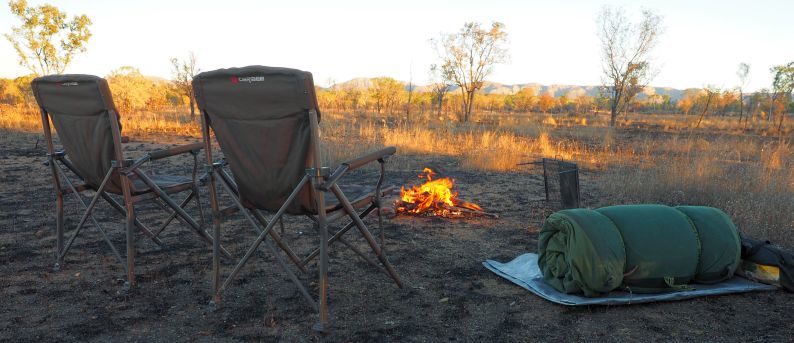Who doesn’t love a great campfire meal after and active day exploring stunning places like Kakadu National Park or the Kimberley Region? It’s the perfect way to end a day. Yes, you could just cook on a portable gas stove while camping, but what would be the fun in that? Campfires are a big part of any true Australian camping experience, so we have put together some of our favourite campfire recipes for you to try.
Fire Preparation
First of all, you will need to ensure that you have a good cooking fire. A camp cook is only as good as his/her fire, and a big part of a good fire is the wood used. Aim for dry hardwood, branches that have fallen and split, never use green wood. You want a medium thickness to achieve a good constant heat. Later you can add bigger branches. You will need dry leaves, grass or twigs to start your fire. Once you have a good flame, top up with wood, starting from small and getting bigger as the flame catches. The amount of wood needed will depend on what you are cooking and whether you need coals or flame (or both). In order to reduce resource depletion, never use more wood than what you need to cook with. Once your flame has settled down, put on your BBQ plate and control the heat by shifting coals and wood with your spade or shovel. Never collect wood around your camp, ensure you collect your wood from appropriate areas while travelling, and always supervise children around campfires!
Easy and delicious camp oven bake
Let’s start with a classic perfect for filling hungry explorer tummies. Use hard vegetables such as potatoes, pumpkin, carrot, sweet potato and corn, add onion if you like. Added advantage: hard vegetables do not necessarily need to be kept in a cooler, so you can eat healthily even if you have limited cold storage. Of course you can get creative and use vegetables such as capsicum and beans etc., however, you will need to be more careful with your heat as they burn more easily. Cut your veggies into chunky pieces, put them in your camp oven and add a generous amount of olive oil and garlic, herbs, salt and pepper to taste. Stir thoroughly, put your lid on and place your camp oven on your BBQ plate or directly on the fire if you have a low flame with good coals. You will need a medium heat for the cooking process. Now simply sit back and wait while listening to the sizzling of your veggies, it should take 30-40 mins for your vegetables to cook. Once almost done, BBQ your steaks, sausages or meat/ veggie burger of your preference on your hot plate and serve together.
Fish and vegetables in foil
This is a great recipe if you do not have many pots and pans or if you tend to burn more food directly on the hot plate than what is left to eat… Prepare pieces of aluminium foil, place your fish fillets in the foil and add some olive oil (not necessary on fatty fish such as salmon), herbs, garlic etc. to your liking. Cajun is delicious! Use two layers of foil to avoid burning, don’t wrap the foil too tightly- leave some room for air to develop heat and steam. For easier opening once cooked, wrap the foil around only once, fold over the sides and roll the foil down from the top. Place your foil packages on your hot plate over a medium heat. Do the same with your vegetables, chopping them into wedges and adding olive oil and spices. Turn your packages with tongs after approx 10 mins. To test if your veggies are done, you can use a fork, however, this will let steam/ heat escape so be patient and don’t do it too soon or too often. It should take around 20-30 mins to cook everything.
Potatoes cooked in coals
An all-time favourite, however, it takes some experience to cook the perfect spud in coals. Again, it’s all in the preparation. You need good coals from good solid hardwood. You will need to have time at camp to start your fire early so that you have enough coals when you need them. Even better if you can use an existing fire pit that has recently been used and still has some good coals and ash in it. Prepare your potatoes by scalloping them slightly, making a few vertical cuts about half way through your potato. This will help the cooking process. You can also rub some olive oil and salt on before wrapping the potatoes in two layers of foil. Once you have good glowing coals, place a layer of coals fireside, then place your potatoes on the coals. Finally, evenly cover your potatoes with more hot coals then a layer of fire ash to help keep the even heat in. Let the potatoes cook for about 30 minutes before testing (you can spike the potato to test the cooking consistency). Get your potatoes out of the coals with your tongs (heatproof gloves are very handy for burn prevention) and be careful not to burn yourself when opening the foil packages once they are on the table. Hot tip: If you are a pro you have counted your potatoes to make sure you retrieve them all from the fire! Top the potatoes with grated cheese and sour cream if you like, and serve with your favourite meat, fish or tofu and a healthy salad.
The quantities needed for the above recipes will depend on your group size and appetite, so we will leave that up to you. Keep an eye on our blog for more delicious recipes to come, including desserts and camp oven recipes.
Important notes: Please ensure you do not collect more wood than you need. With the high numbers of campers in the Top End and the Kimberley, fallen wood can be depleted quickly through a season, and your fellow explorers will miss out. NEVER rip or cut branches off living trees (yes, we see it all the time). That wood won’t be any good anyway as it is green. When visiting national parks, check their wood policies. Some parks require you to bring in your own wood, while other parks have designated wood collection areas. We hate holes being dug in the ground, often not refilled after use and leaving trip hazards and scars on the landscape. This is another unnecessary process, much like our other pet hate of creating and leaving rock fireplaces! How many campsites have you come across with numerous holes that have been dug and fireplaces that have been built and left? Neither are required, and in keeping with minimal impact camping guidelines, take only photographs and leave only footprints.


